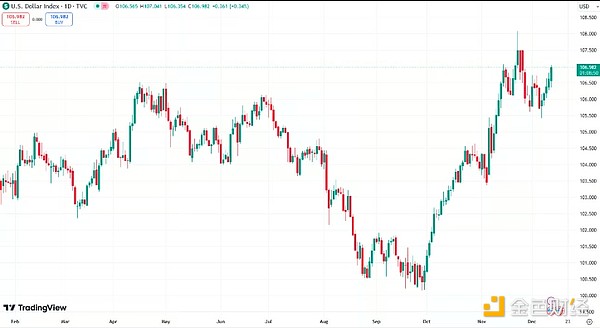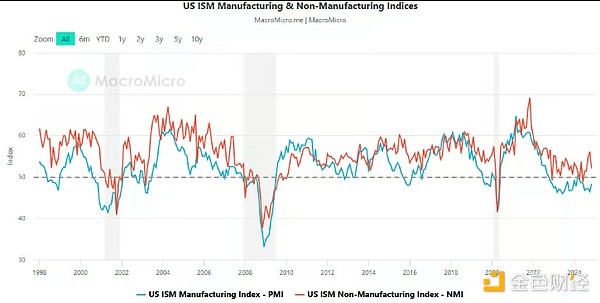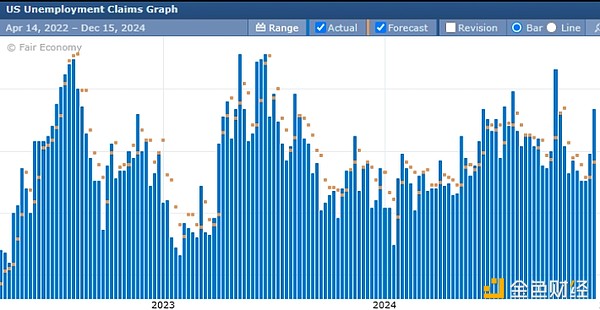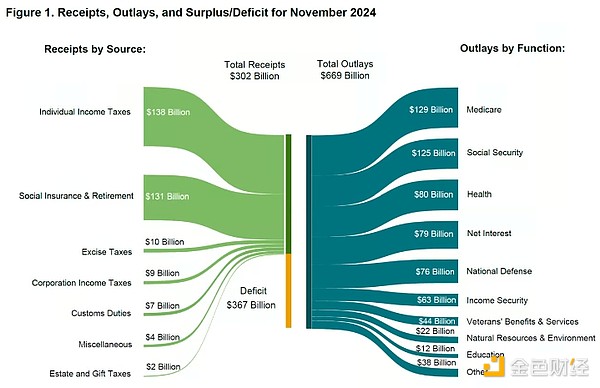How will global macroeconomic trends impact the cryptocurrency market in 2025?

Reprinted from jinse
12/18/2024·6MAuthor: Michael Nadeau, The DeFi Report; Compiler: Wu Baht, Golden Finance
We've said it many times: if you don't understand macroeconomic trends, you don't understand cryptocurrencies. Of course, the same is true for on-chain data.
This week, we explore how macroeconomic trends will impact the cryptocurrency market in 2025.
inflation
Inflation numbers are rising. After bottoming at 1% in September, we have accelerated our recovery to over 3% on a truflation basis.

Data:Truflation
We like Truflation's data because it uses real-time web scraping data from a variety of online sources. In addition, it is updated more frequently than traditional government indicators such as PCE.
However. The Fed's focus is on PCE. Therefore, we use PCE as a way to predict Fed policy and Truflation to get a more real-time view of the economy.
This is personal consumption expenditure:

Data: FRED database
It is currently 2.3% (October data). is also rising - which is hard to see in the chart (2.1% in September). We'll have November data on December 20th.
views on inflation
Energy costs and housing costs are the main drivers of growth. However, crude oil prices are at cycle lows.

Data:: Trading Economics
The question is whether they will stay here, or perhaps fall further.
Given the seasonal effects + Trump's plans to increase supply through US deregulation, it's hard to see why oil prices would surge any time soon.
On the other hand, geopolitical conflicts, unforeseen natural disasters, or OPEC production cuts in anticipation of increased U.S. supply could cause oil prices to rise.
We haven't seen these events happen yet.
Furthermore, our position is that inflation in the 21st century has been caused primarily by supply shocks + fiscal spending and stimulus checks - which we do not view as a threat today.
Therefore, we expect oil prices to be range-bound and inflation/growth to fall.
Dollar

Data: Trading View
Since October 1, Bitcoin is up 58%. Meanwhile, the U.S. dollar index rose from 100 to nearly 108. Today's ranking is 107.
This is a special behavior. Typically, a stronger dollar is detrimental to risky assets like Bitcoin (see 2022). But we now see a strong correlation between the two.
So what's going on? Should we be worried?
We believe the USD is showing strength as global markets price in a Trump victory. Trump’s policies are pro-business. This means they are good for the market.
We saw the same dynamic after Trump’s victory in 2016. The dollar rose. Why? We believe foreigners are digesting the impact of the “Trump Rump” and buying USD-denominated assets as a result.
Views on the US dollar
We believe growth is slowing/normalising. This is lowering inflation, albeit with a delay. Interest rates may fall.
Therefore, we expect the US dollar to be range-bound over the medium term, possibly back towards 100.
ISM data (business cycle)

Data: MacroMicro
Looking at the economic cycle, we can see that the blue line (manufacturing) appears to be bottoming out. Historically, a reading below 50 indicates the economy is in contraction. A sustained reading below 50 indicates a slowdown.
That's where we are now - service (red line) is doing slightly better.
These levels tend to coincide with increases in unemployment. This typically results in the Federal Reserve adopting loose monetary policy.
again. That's exactly what we're seeing today.
Perspectives on the business cycle
We believe growth is slowing, leading to higher unemployment. This could ultimately manifest as downward pressure on inflation.
This resulted in interest rate cuts. This puts downward pressure on the US dollar.
Over the medium term, we believe these dynamics should support risk assets/cryptocurrencies.
credit market

Data: FRED
Credit spreads continue to be at historically low levels, suggesting investors are less demanding in compensation for additional units of risk.
This could mean two things: 1) The market is complacent and risk is mispriced. Or 2) market participants are optimistic about the economy and the Fed and fiscal policy are loose.
We think it's the latter.
Next we look at trends in bank lending.

Data: Fred Database
The proportion of banks tightening lending standards has been falling since peaking in late 2023. Ideally, this KPI will remain stable as the Fed cuts interest rates.
Having said that, historically we have seen an inverse correlation between interest rate cuts and the proportion of banks tightening lending standards. Why? Rate cuts often signal an economic slowdown or recession - making it harder for banks to lend.
Views on credit markets
No sign of stress. At least not yet.
labor market
The unemployment rate rose to 4.2% in November (previously 4.1%). Below we can see the recent rise in jobless claims.

Data: Forex Factory
We believe labor market weakness now has the Fed's full attention. The continued rise in unemployment claims data tells us that for those who are out of work, finding work is becoming increasingly difficult.
This is another sign of slowing/normalizing growth. That being said, the stock market remains at all-time highs. Corporate profits are strong. This is what keeps the labor market intact.
But my sense is that the Fed is watching this like a hawk. After all, Sam's Rule was triggered in July.
Views on the labor market
It's softening. But it's not fast. We expect the Fed to (try to) act before the data weakens (as they already cut rates by 50 basis points in September after the July SAM data).
Treasury and fiscal expenditures

Data: U.S. Treasury Department
The U.S. government spent $1.83 trillion more this year than it collected in taxes. In November alone, it spent more than double its revenue.
The $1.83 trillion that has been printed and pushed into the economy/Americans has been the main driver of financial markets this year (and in our opinion the main driver of inflation).
Now. Trump is coming. We also have a new agency called DOGE, the Department of Government Effectiveness, headed by Elon Musk.
Some believe excessive spending will be reduced as a result. Maybe it will. But which departments will be cut? Medicare/Social Security? army? interest?
That's 65% of the budget - which seems untouchable.
Meanwhile, the Treasury must refinance more than a third of its debt next year. We don't think they can do that by raising interest rates.
Views on treasury/fiscal spending
We believe significant cuts in fiscal spending are unlikely in the short term. DOGE may cut spending by $10 billion. But it won’t change the status quo in a substantive way. This will take some time.
Meanwhile, the Treasury will need to refinance a third of all outstanding debt next year. We think they'll do it with lower interest rates.
Combining these views, we are optimistic about the outlook for risk assets/cryptocurrencies.
Fed policy
The next FOMC meeting will be held on December 18, and the market currently predicts a 97% chance of a rate cut. We think this could also give China the green light to ease policy.
Why?
We believe China wants to continue its easing policy. But when the Fed doesn't cut rates, it will be difficult for them to do so because the yuan will weaken against the dollar, making Chinese imports more expensive.
Thoughts on Fed policy
A rate hike appears unlikely in the near term. A rate cut in December is almost a certainty, with market pricing pausing at 76% in January. There will be no FOMC meeting in February.
Therefore, the next policy decision will not be made until March. We believe the labor market may now show more signs of weakness, and the Fed may cut interest rates further in mid-to-late 2025 - ultimately to around 3.5%.
Will interest rate cuts increase inflation? We don’t think so – it’s a non- consensus view. In fact, we think rising interest rates are causing inflation (and other fiscal spending) to rise.
Why?
Because interest payments now exceed $1 trillion. The money is printed and passed on to Americans who hold bonds, and the money appears to be pumped into the economy. Of course, rising interest rates have not caused banks to stop lending (see chart above).
Therefore, we believe that inflation is likely to decline as the Fed cuts rates (assuming oil prices remain low and we do not see further increases in fiscal spending). Remember, we had zero interest rates for 10 years with low inflation. Japan has had 0% interest rates for 30 years and has a low inflation rate.
trump policy
The market knows what a Trump presidency will bring:
-
Lower taxes. This should boost corporate profits and potentially lead to a rise in share prices. It could also lead to greater income inequality and larger deficits. More deficits = more dollars in the hands of Americans.
-
Tariffs/“America First.” This could lead to higher domestic prices. We think AI/automation may actually offset this to some extent.
-
Deregulation. This is good for business as it could lead to higher profits in the energy, technology and financial sectors.
-
Stronger borders. This can lead to labor shortages and rising wages (inflation).
Thoughts on Trump’s policies
We think Trump is generally good for business, free markets and asset prices. The trade-off is that we may see some inflationary impulses. This is where things get interesting, as the Fed will seek to pause interest rate hikes or tighten monetary policy if inflation returns.
Of course, we think Trump will try to impose his will on Jerome Powell. Ultimately, we think Trump wants to boost the economy and eliminate some of the debt through inflation over the next four years. This means that inflation must exceed nominal interest rates, but that is not the case today.
Finally, given Trump’s support for the digital asset industry (and the incoming SEC chairman), we believe cryptocurrencies will benefit from his administration.
Not to mention the potential for favorable legislation from Congress and the strategic reserve of Bitcoin in the coming years.
Thoughts on Trump’s policies
We believe that a Trump administration will be good for cryptocurrencies from a market and regulatory perspective.
China
Dan Tapiero (one of my favorite macro investors) says China is currently experiencing deflation (negative real interest rates).
China's negative interest rates have dampened U.S. inflation concerns. This makes the dollar stronger (as we are seeing today).
A U.S. interest rate cut may lead China to do the same.
Ultimately, it will lead to more global liquidity.
Speaking of global liquidity.
global liquidity
Given that 1/3 of US debt will need to be refinanced over the next year, we believe the Fed may have to step in as the buyer of last resort (QE).
Lower U.S. interest rates will allow China and Europe to ease conditions in some coordinated way.
We believe this will lead to ample liquidity/collateral within financial markets – with cryptocurrencies/risk assets being one of the biggest beneficiaries.
These dynamics are consistent with the fourth year of the crypto cycle—the most volatile upcycle in history.
Summarize
-
Growth is slowing.
-
This is causing labor market instability (and the Fed is watching).
-
This leads to interest rate cuts (as we are seeing today).
-
This allows China and Europe to ease conditions without sacrificing currency/imports.
-
This creates favorable liquidity conditions for risk assets.
This is the future we see.
Factor in fiscal spending, the incoming Trump administration, and the fourth year of the cryptocurrency cycle, and you can predict explosive bull market conditions in 2025 (expect volatility).
Of course, we will continue to monitor the market and provide you with the latest information from an on-chain data + macroeconomic perspective.
After all, if you don’t understand the macroeconomic situation, you don’t understand your cryptocurrency.


 panewslab
panewslab